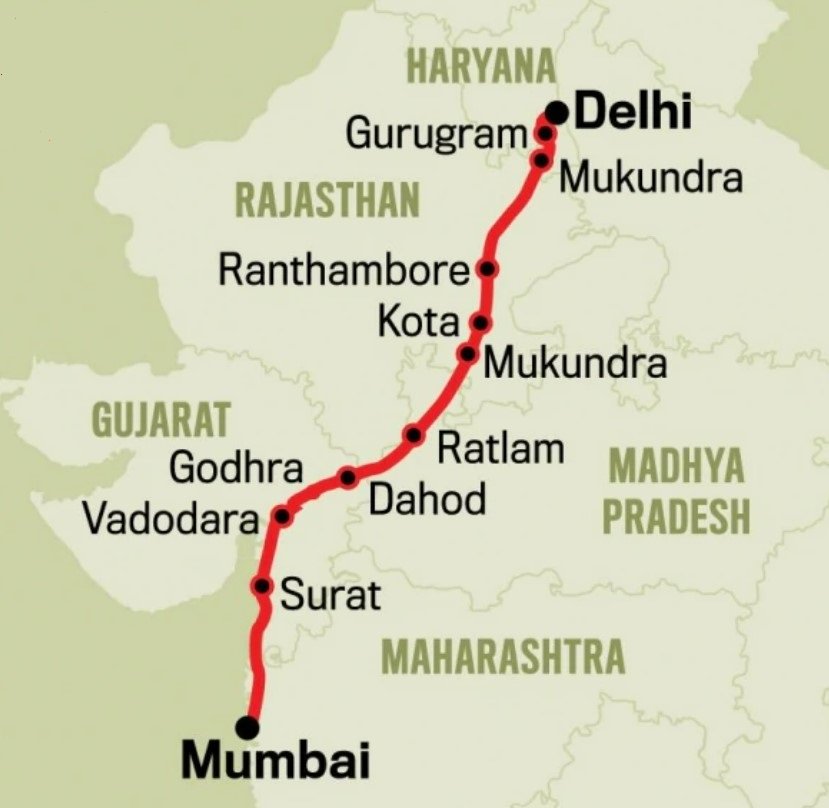The Delhi-Mumbai Expressway, a monumental infrastructural masterpiece, is poised to reshape India’s connectivity and accelerate its economic growth. Spanning 1,350 kilometers and expandable to 12 lanes, this transformational project links New Delhi, the nation’s political capital, to Mumbai, its financial epicenter. Journey with us as we delve into its route alignment, track its construction progress, and explore the profound impact it will have on India’s landscape and future.
Pioneering an Electric Highway
The National Highways Authority of India (NHAI) is converting a stretch of the expressway into an “e-highway” for trucks and buses that is powered by electricity as part of a progressive program. This novel method minimizes the environmental impact while simultaneously cutting logistics expenses.
Championing Environmental Sustainability
The Delhi-Mumbai Expressway is designed with environmental sustainability as its cornerstone. It will feature a lush tree canopy comprising 20 lakh trees, nourished through drip irrigation, and complemented by a comprehensive rainwater harvesting system every 500 meters. Furthermore, solar energy will illuminate the expressway, offering a cleaner and greener alternative.
Delhi-Mumbai Expressway Route Alignment
The Delhi-Mumbai Expressway traverses a diverse landscape, connecting major cities and regions along its path. Here’s a detailed look at its route alignment:
Section 1: DND-Faridabad-KMP (Delhi to Haryana)
- Begins at Maharani Bagh, Delhi, connecting to the DND Flyway.
- Passes through Khizrabad, Batla House, and Shaheen Bagh on the west bank of the Yamuna River.
- Follows the Agra Canal route from Okhla Vihar metro station to Mithapur.
- Crosses into Haryana near the MCD Toll, Mithapur Chowk.
- Interchanges with the KMP Expressway at Khalilpur
Section 2: Sohna-KMP-Vadodara (Haryana to Gujarat)
- It begins at Alipur village, Gurgaon district, Haryana.
- Interchanges with NH-919 (Sohna-Palwal) at Sancholi village
- Trumpet interchange with the KMP Expressway at Khalilpur village
- Crosses into Rajasthan at Munpur Karmala village.
- Interchanges with various highways include SH-45, SH-14, SH-44, NH-921, NH-21, NH-148, NH-23, NH-552, SH-29, SH-70, NH-27, and SH-9A.
- It exits Rajasthan at Moondiya village, Kota district.
Section 3: Vadodara–Virar (Gujarat to Maharashtra)
- Enters Gujarat at Chhayan village, Dahod district.
- Interchanges with NH-56 and NH-47.
- Connects with the NE-1 Ahmedabad interchange at Dodka village.
- crosses the Gujarat-Maharashtra border.
- Enters Maharashtra near Virar.
Section 4: Virar–JNPT (Maharashtra)
- Runs through Palghar, Thane, and Raigad districts in Maharashtra.

Special Features That Distinguish
The Delhi-Mumbai Expressway boasts a multitude of special features that set it apart. Wayside amenities will grace 93 locations, offering conveniences such as ATMs, hotels, retail shops, food courts, and even charging stations for electric vehicles. Additionally, it will be the first Indian expressway to incorporate helipads and fully-equipped trauma centers every 100 kilometers, a crucial lifeline for accident victims.
Delhi-Mumbai Expressway Construction Update
The construction of the Delhi-Mumbai Expressway is a mammoth task divided into multiple phases:
- As of February 2023, Prime Minister Narendra Modi inaugurated the 246-kilometer-long Sohna-Dausa-Lalsot stretch of the expressway, marking significant progress.
- By September 20, 2023, the Madhya Pradesh section covering 244 kilometers had been opened, further advancing the project.
- As of December 2022, approximately 1,063 kilometers of the expressway were under construction, with seven packages totaling 202 kilometers completed.
- The entire expressway is expected to be open by January 2024, according to President Ramnath Kovind’s statement during the Budget Session.
Conclusion
The Delhi-Mumbai Expressway is not merely a highway; it is a symbol of India’s determination to modernize and connect its diverse regions. As construction progresses, the benefits of reduced travel times, economic growth, and environmental sustainability become increasingly tangible. This monumental endeavor will undoubtedly reshape India’s infrastructure landscape and set the stage for a brighter future.




